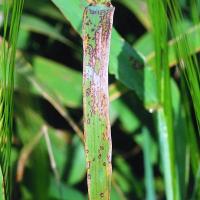Diagnosing halo spot
A stubble-borne fungal foliar disease of barley cause by Pseudoseptoria donacis (synonym Selenophoma donacis). It occurs more frequently in high rainfall areas of the West Australian (WA) wheatbelt but rarely becomes severe enough to reduce yield.
What to look for
- Small white to light brown lesions with dark brown edges that often occur towards the tips and edges of leaves first, and then may merge resulting in larger areas of necrosis.
- Lesions frequently run along leaf veins, resulting in squarish blotches.
- New lesions form elongated spots and have purple-brown margins.
- Within the lesions rows of many tiny dark fruiting bodies may be apparent.
Plant
What else could it be
| Condition | Similarities | Differences |
|---|---|---|
| Diagnosing ring spot in cereals | Small lesions with a brown to black margin | Halo spot differs in that lesions frequently run along leaf veins resulting in squarish blotches that contain lines of small black fruiting bodies |
| Diagnosing wirrega blotch | Small lesions with a brown to black margin | Halo spot differs in that lesions frequently run along leaf veins resulting in squarish blotches that contain lines of small black fruiting bodies |
Where did it come from?

Contaminated stubble
- The fungus is carried from season to season on infected barley stubble, regrowth barley and wild grass species.
- When wet, stubble borne fruiting bodies release wind blown spores that infect young barley crops.
- Spores released from infected leaves are spread from leaf to leaf by rain splash under cool wet conditions.
Management strategies
- Treatment is rarely required.
Where to go for expert help
Page last updated: Thursday, 16 April 2015 - 10:24am



